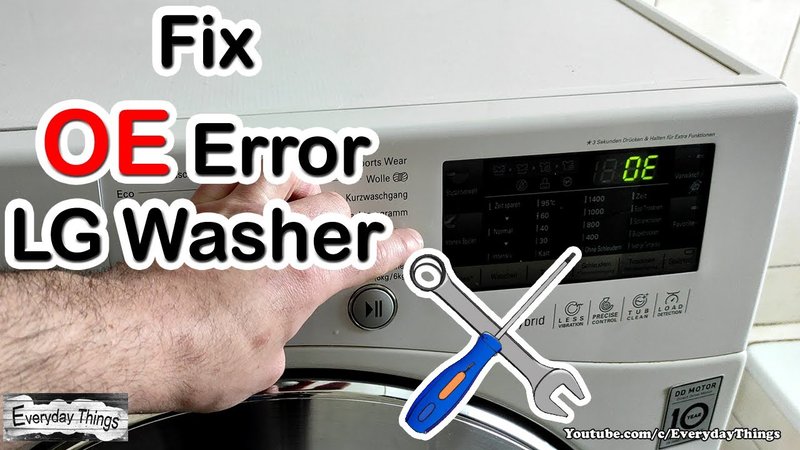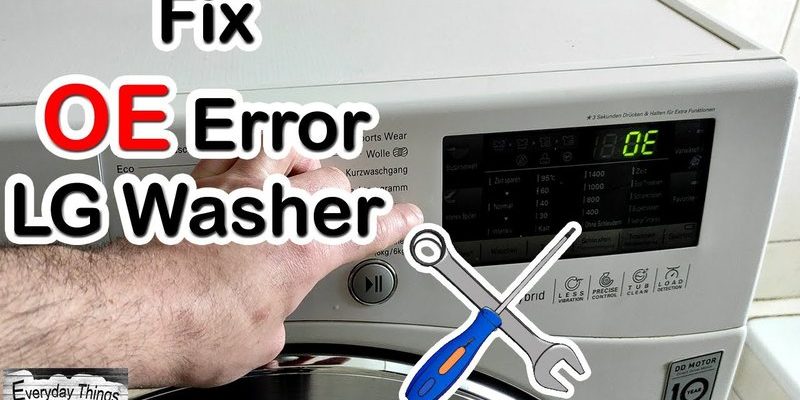
Here’s the deal: the “OE” error code on your washing machine is essentially its way of letting you know there’s a problem with draining the water. Think of it in terms of a bathtub: you’ve finished your bath, and when you pull the plug, the water should flow smoothly down the drain. If it doesn’t and instead stays in the tub, you’d likely suspect a clog. Similarly, when the water in your washing machine isn’t evacuating as it should during the cycle, the machine will signal the “OE” code. Now, let’s dive deeper into understanding why this happens and how you can tackle it without needing to call in a professional.
Understanding the “OE” Error Code
Before panicking, it’s important to grasp what the “OE” error code is trying to communicate. The “OE” stands for “Outlet Error,” but in simpler terms, it means that your washing machine is having trouble draining water. Imagine it as a signal from your machine saying, “Hey, there’s a blockage somewhere, and I can’t get the water out!”
One of the most common reasons for this error is a clogged drain pump filter. Over time, bits of fabric, lint, and other debris can accumulate, causing a blockage that hinders the water from draining out. It’s almost like the filter is wearing a little fur coat, which is not ideal for its functionality. Also, a kinked or clogged drain hose can equally contribute to this problem. So, if you’ve ever seen a garden hose with a kink, you know the water won’t flow as freely. The same principle applies here.
Additionally, there might be an issue with the actual drain pump itself. If the pump is malfunctioning, it won’t be able to push the water out even if the pathways are clear. Think of it like a football player with an injured leg—no matter how open the field is, the player isn’t going anywhere fast. Yet, before you start worrying about pump replacements, let’s explore some steps you can take to troubleshoot and possibly fix the issue yourself.
Steps to Resolve the “OE” Error Code
Okay, time for some hands-on action! First things first, let’s tackle the easiest potential fix, which involves checking the drain pump filter. This is an excellent place to start since it’s accessible and often the culprit. Unplug your machine for safety, and locate the small access panel on the bottom front of your washer. Inside, you’ll find the drain pump filter, which needs a good cleaning. Gently unscrew it, but be ready with a towel to catch any water that might spill out. Clean out any gunk, rinse it under water, and put it back securely.
Next, examine the drain hose. Is it straight and free from obstructions? Pull it out and give it a gentle shake or blow to clear any blockages. Ensure it’s positioned correctly, usually about 3-5 feet above the ground, so gravity can do its thing. If the hose is twisted or has kinks, this could prevent the water from flowing out smoothly.
If after these steps the “OE” code still flashes angrily at you, your pump might indeed be the issue. This is the point where you might want to consult your user manual or reach out to a professional. While it’s possible to replace a malfunctioning pump on your own, it’s a more complex task that may require some technical know-how.
Preventing Future “OE” Errors
Now that you’ve hopefully resolved the issue, let’s talk prevention. Just like regular car maintenance, taking care of your washing machine can save you from future headaches. Consider cleaning the drain pump filter regularly. Make it a routine part of your laundry schedule—maybe every month or so, depending on how often you use your machine.
Always be conscious of what you’re putting into the washer. Small items, like coins or buttons, can escape pockets and become lodged in the filter or pump. Using a mesh laundry bag for small or delicate items can help keep things contained. Also, make sure your drain hose remains free from kinks and obstructions.
Consider this your laundry machine’s wellness check-up. A little attention now can prevent that “OE” error from crashing your laundry day in the future. It’s always better to be proactive rather than reactive when it comes to household appliances.
So, there you have it—simple, practical steps to troubleshoot and prevent the pesky “OE” error code on your LG washing machine. Just remember, it’s all about keeping the water flowing smoothly, kind of like life. With a bit of maintenance and care, your washing machine will continue to be your steadfast chore companion.
